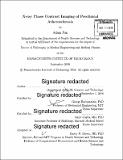X-ray phase contrast imaging of preclinical atherosclerosis
Author(s)
Pan, Adam, Ph. D. Massachusetts Institute of Technology
DownloadFull printable version (23.35Mb)
Other Contributors
Harvard--MIT Program in Health Sciences and Technology.
Advisor
George Barbastathis and Rajiv Gupta.
Terms of use
Metadata
Show full item recordAbstract
Atherosclerosis is the leading causes of mortality and morbidity in the world. While there are a plethora of methods for treating clinical atherosclerosis, the primary cause of mortality is acute coronary syndrome (ACS) following rupture of an atheroma, an event that is poorly predicted and remains the most common first indicator of cardiovascular disease. Current tools for determining atherosclerotic burden rely assessing a patient's risk factors, clinical symptoms, and biochemical profile, followed by angiographic imaging. However, patients with subclinical atherosclerotic disease can also be at high risk for ACS. In fact, nearly half of the patients suffer from sudden cardiac death without any prior indication of atherosclerotic disease. For these patients, proper characterization of the plaque burden has been shown to have a strong diagnostic value in guiding preventative treatments. Current noninvasive medical imaging methods lack the combination of resolution and contrast required to characterize atherosclerotic plaque. Recently, a new mode of medical imaging known as X-ray phase contrast imaging (XPCI) has been shown to produce exceptional contrast in soft tissues, and has the potential to noninvasively characterize atherosclerotic disease. This thesis develops a new experimental XPCI system, as well as novel algorithms for reconstructing the amplitude and phase of X-rays for the purpose of noninvasive imaging of atherosclerotic disease. Our methods extend the transport of intensity equation, which enables the retrieval of phase and amplitude from multi-dimensional intensity distributions. We present a compressive tomographic reconstruction framework for 3-dimensional phase distributions, including algorithms for both single-shot and multi-shot phase retrieval. We introduce a method for compressive phase tomography based on the phase attenuation duality. We further propose a novel regularization scheme for projection imaging called the structural similarity regularizer, which exploits the sparsity of phase edges according to an absorption prior. Finally, we present an algorithm known as simultaneous attenuation phase retrieval, which is capable of combining absorption and phase information to improve reconstruction results. For each algorithm, we present simulation and experimental results from test phantoms and biological specimens. The results of this thesis show that X-ray phase imaging can successfully characterize atherosclerotic plaques, and lays the groundwork for the use of XPCI as a diagnostic tool for atherosclerosis.
Description
Thesis: Ph. D. in Medical Engineering and Medical Physics, Harvard-MIT Program in Health Sciences and Technology, 2016. Cataloged from PDF version of thesis. Includes bibliographical references (pages 151-167).
Date issued
2016Department
Harvard University--MIT Division of Health Sciences and TechnologyPublisher
Massachusetts Institute of Technology
Keywords
Harvard--MIT Program in Health Sciences and Technology.